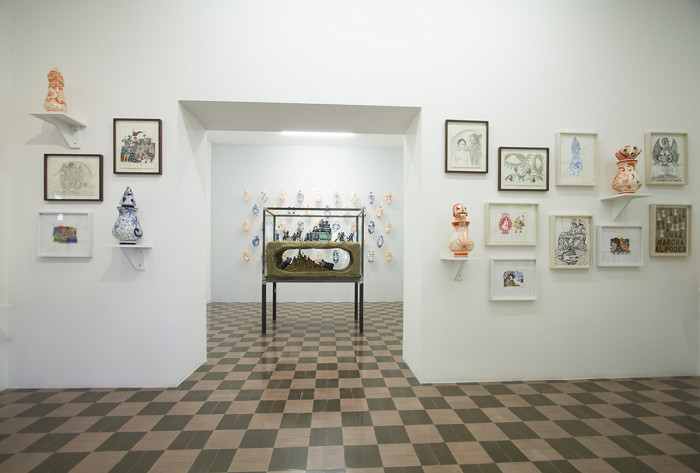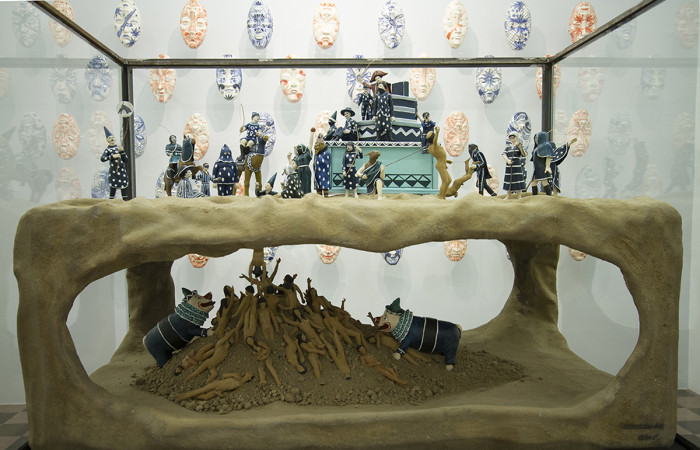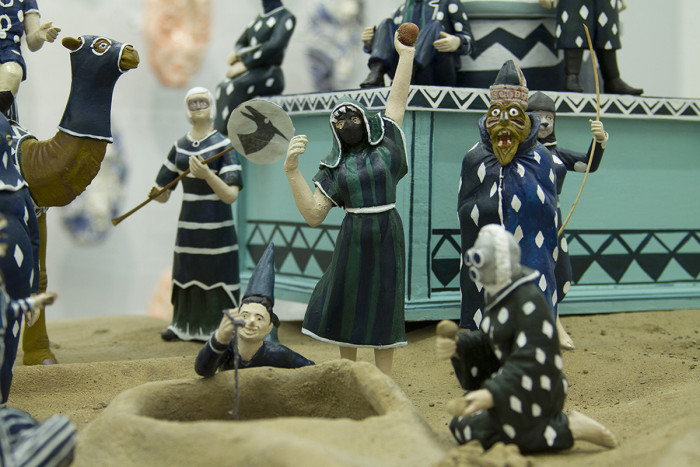Reading time: 4 minutes

27.03.2015
Travesía Cuatro, Guadalajara, México
January 31, 2015 – March 31, 2015



Is it possible to create a reinterpretation of history that ignores the impulse to be consistent with real facts? Even though the collaboration between Marcel Dzama and Eduardo Sarabia does not attempt to answer this question, it brings up a series of involuntary answers that evidence an alternative approach. Firstly, it manifests a refusal to understand the past in terms of victories and failures, which enables the artists to distance themselves from the univocal tale, legitimized as true, in order to inquire into the peripheral events, ignored and disqualified by historians, assuming the dynamic and unresolved potential of history.
Campeonato de Guadalajara is the denial of a historical narrative composed by as assortment of montionless facts, it is the reanimation of what is considered to be inert. It is the remembrance of a chess tournament in Nice, for which Marcel Duchamp designed a poster and, simultaneously, it is a fragmented interpretation of the Florentine Codex, employing both artists’ visual languages. It is a sequence of secret rites performed by ballet companies gathering hooded terrorists and anthropomorphized animals, using costumes designed by Oskar Schlemmer and Francis Picabia. This collaboration is not a translation exercise; it does not seek to reach a consensus to establish a code that surpasses the contextual differences between the artists. Instead, it opts for a simultaneous dialogue, with interferences and interruptions.
Sarabia seeks to counteract the mythological constructs that operate behind the iconography associated with illegal drug trade in México by transforming it into merchandise that may look like souvenirs from Mexican aesthetics. The popular imagery that usually inhabits these crafts is replaced by the reality of mass media that has installed itself at the level of everyday life. Meanwhile, Dzama has created an entire cast of characters that inhabits his work, they are forced to depict situations that could be the product of an infantile mind speculating about the nature of violence: despite being an explicit exploration of the macabre, a naïve and innocent character prevails. The represented events reject any sort of narrative coherence, creating vignettes consisting of paused and suspended ecstatic moments, making the viewer feel as if they were interrupting a pagan celebration.
Both artists aim to reconcile apparently contradictory worlds: the popular and recognizable with the occult and incomprehensible. The ways in which they manifest the contradictions between these two dimensions reveals a fracture of the archetypal understanding of the world. Sarabia accentuates this discordance by means of normalizing reality in form of merchandise, while Dzama resorts to the emulation of euphoric, violent, and sexual frenzy.
MARCEL DZAMA (Winnipeg, 1974)
Marcel Dzama’s work is characterized by an immediately recognizable visual language that draws from a diverse range of references and artistic influences, including Dada and Marcel Duchamp. While he has become known for his prolific drawings with their distinctive palette of muted colors, in recent years, the artist has expanded his practice to encompass sculpture, painting, film, and dioramas.
In 2010, a major survey of the artist’s work was presented at the Musée d’art contemporain de Montréal in Montreal. Other recent solo exhibitions include those organized by Kunstmuseum Thun, Switzerland (2014); Centro de Arte Contemporáneo de Málaga, Spain; Museo de Arte de Zapopan (MAZ), Zapopan, Mexico; Pinakothek der Moderne, Munich (2008); and Le Magasin – Centre National d’Art Contemporain de Grenoble, France (2005). Work by the artist is held in museum collections worldwide, including the Museum of Contemporary Art, Los Angeles; The Museum of Modern Art, New York; Ottawa; Solomon R. Guggenheim Museum, New York and the Tate Gallery, London. Dzama lives and works in Brooklyn, New York.
EDUARDO SARABIA (Los Angeles, 1976)
Eduardo Sarabia was educated at the Otis College of Art and Design in Los Angeles. Eduardo Sarabia’s work takes its starting point in the history of Mexican society, investigating Pre-hispanic myths and their influence on current Mexican culture as well as topics of interest in the current political reality of the country – such as conflicts related to the drug war and class inequality. Characteristic of his work is a variety of aesthetic and symbolic components from both ancient and contemporary Mexican culture. Sarabia’s work does not, though, reflect the moral state of modern Mexico, but rather seeks to reveal a reality that goes beyond the values promulgated by the system.
Sarabia’s oeuvre has been featured in solo exhibitions held by institutions such as the Museum of Contemporary Art Denver, Colorado; Tokyo Wonder Site in Tokyo, Japan; LA Louver Gallery in Los Angeles, California and The Santa Monica Museum of Art, California. Some of the most prominent group exhibitions to include the work of the artist are: New Blue and White, Museum of Fine Arts, Boston (2013); Turn Off the Sun: Selections from La Colección Jumex, The University of Arizona Museum of Art, Tempe (2013) and Fuerzas básicas, formas del dibujo reciente en Jalisco, Museo de la Ciudad, Guadalajara (2011). The artist lives and works in Guadalajara, Mexico.
Link: http://travesiacuatro.com/
Comments
There are no coments available.